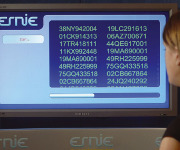Should first time buyers opt for Lloyds ‘no-deposit’ mortgage?

There are many other ways parents can help their cash-strapped children get on the housing ladder.
Getting together a deposit is one of the biggest hurdles facing first-time buyers.
Almost half (43%) of 18-35 years old's say it’s stopping them getting on the ladder, while a similar proportion of parents (41%) say they’d like to help their children financially but need the money for later life.
Lloyds Bank says its latest mortgage product will suit both groups.
The Lend a Hand mortgage requires no deposit or upfront fees. Instead, parents put savings equivalent to 10% of the property’s price in a savings account for three years.
They then get it back, providing nothing goes wrong, having earned an interest rate of 2.5%, currently equivalent to the top rate in the market for three-year fixed-term deposits.
Meanwhile, their kids pay an interest rate of 2.99%, fixed for three years, which is a little above average, but not as high as many first-time buyer mortgages.
And, because you get your savings back, you could potentially use them to get several children onto the property ladder, one after another.
There’s even £300 cashback for the parents and £500 for the kids.
So, has Lloyds solved the first-time buyer dilemma?
How to buy your first home: read our full guide here
‘Help to Buy’ properties are excluded
Help to Buy is a scheme where the Government will loan you 20% of the money for a new home – or 40% in London – interest-free for five years.
However, you can only use it for new-build properties from Help to Buy-accredited builders and, unfortunately, Lloyds’ Lend a Hand mortgage can’t be used for new builds, or properties in Scotland or Northern Ireland.
Getting approved for a mortgage isn’t just about the deposit: you need to show you can afford the repayments.
In the case of Lloyds’ mortgage, you’ll need to show you can afford to make repayments on 95% of the property’s value.
Taking the most expensive property permitted by Lloyds – £500,000 – that works out as £2,105 per month for 30 years.
Even taking the average UK first time buyer house price of £212,211 you’ll need to stump up £894 a month and, due to regulations, you’ll get assessed on your ability to pay even more than that.
How the Help to Buy scheme can help you
Should you just give your kids the money?
While it certainly won’t be the case for everyone, many parents of adult children might find they have a little cash to spare, especially with pension freedoms.
Simply gifting your children the money could help them two-fold: it’ll make their mortgage cheaper and easier to get and reduce Inheritance Tax bills.
Here’s why: if you gift them 10% of the property’s value, they’ll only need to get a mortgage for the remaining 90%. They’ll be able to get cheaper mortgage interest rates than 2.99% and access Help to Buy and other assistance schemes.
To the taxman, your gift will count as a ‘Potentially Exempt Transfer’: providing it’s under £325,000, and you live for another seven years, you won’t have to pay any tax whatsoever.
Not sure how to pass on wealth to your children? Take a look at our guide.
Could you lend your kids the money instead?
Many parents will be tempted to lend their children the money directly and cut out Lloyds as the middleman.
Unfortunately, this is unlikely to work out cheaper in practice.
According to David Hollingworth from mortgage brokers London & Country, many lenders will refuse to accept a parental loan as a source of deposit and, when they do, they’ll factor in the repayments as part of their affordability calculations, creating a “vicious circle”.
Hollingworth warns that this approach could “massively reduce your options”, possibly resulting in a more expensive mortgage.
Compare mortgage rates on loveMONEY’s comparison site
What if I don’t have any spare cash?
Post Office’s Family Link Mortgage could help even if neither the parent nor the child has money to spare.
It does this by mortgaging 10% of the parent’s property – which must be mortgage-free – with the children making two sets of repayments for the first five years. The children will need to be able to afford these substantial repayments.
Alternately, Aldermore also offers a no-deposit mortgage where the parents are a ‘guarantor’, meaning their house could be repossessed if the children fall behind on their mortgage. The parents just have to pay legal fees.
Smaller operators like Bath Building even offer no-deposit mortgages where the parents’ income will be considered in the affordability calculations – potentially solving the problem of affording repayments.
However, the interest rates on such mortgages can be high.
Can you afford to buy? We explain ways around a deposit
Don't forget the rival mortgages
Barclays also offers a 100% mortgage, with the parents putting 10% of the value into a savings account for three years.
Unfortunately, the rate the children pays is marginally higher (3%) and the rate the parents receive is slightly lower (2.25%), although as it’s pegged to the Bank of England base rate it could increase.
However, as the Lloyds mortgage requires you to be a Lloyds current account customer, if you don’t live near a local branch of Lloyds than Barclays could be an easier option.
Most Recent
Comments
-
Another fiddle to keep houses overpriced. How about getting interest rates back to normal? That will solve all sorts of problems, but the government has to keep the indebted chancers happy. The responsible can go to hell. It will all end in tears.
REPORT This comment has been reported.
Do you want to comment on this article? You need to be signed in for this feature









28 January 2019